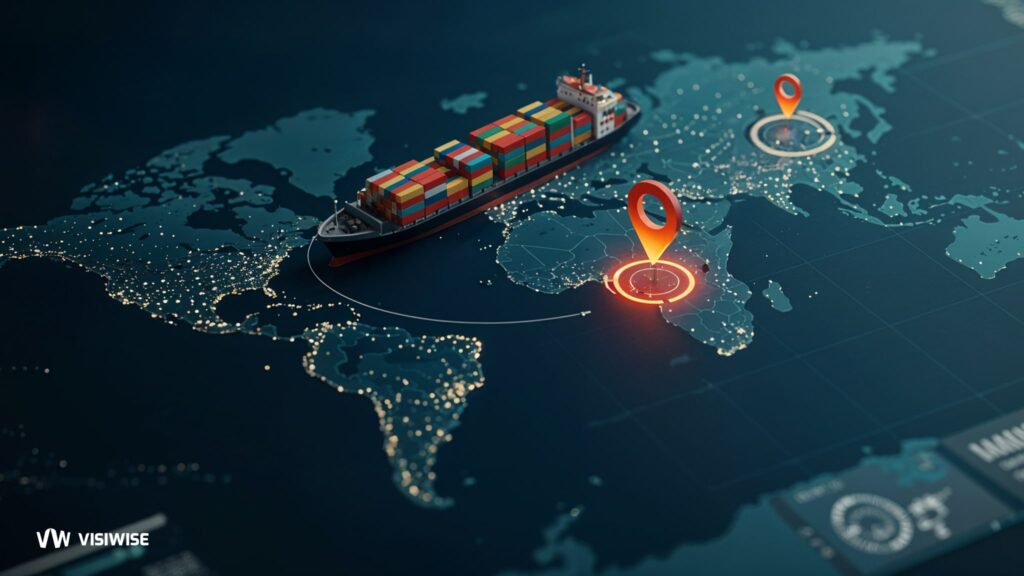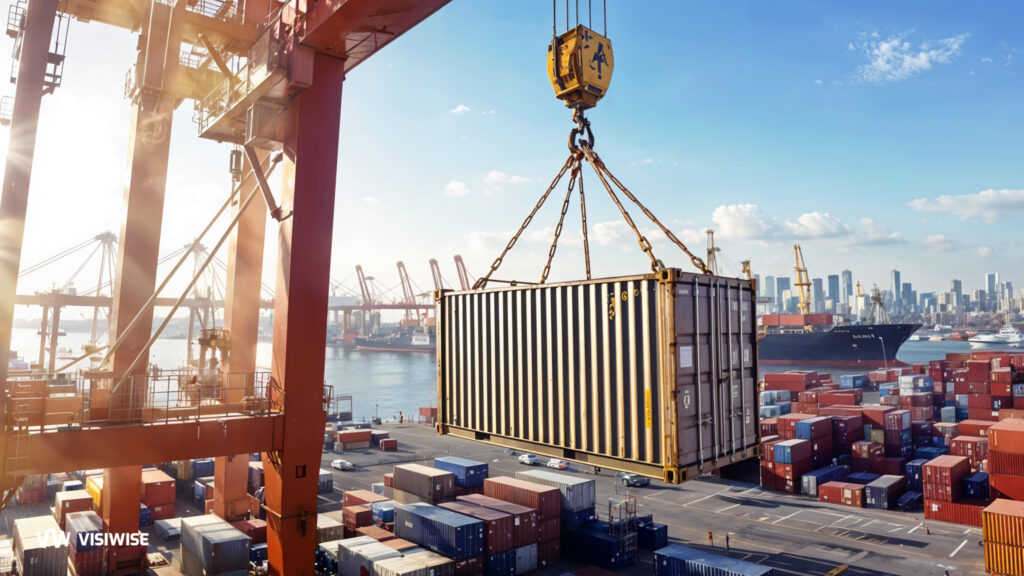Blockchain technology has emerged as a revolutionary force reshaping supply chains across industries, with profound implications for enhancing visibility within the shipping sector. By leveraging blockchain’s decentralized ledger capabilities, businesses are unlocking new levels of transparency and traceability throughout the supply chain. In this dynamic landscape, the shipping industry stands to benefit significantly from blockchain’s ability to streamline operations, mitigate risks, and optimize logistical processes. This article explores the transformative potential of blockchain technology in fostering greater visibility within supply chains and its specific impact on the shipping industry.
What exactly is a Blockchain?
A blockchain is essentially a distributed database or ledger that is shared among nodes within a computer network. While most renowned for their integral role in cryptocurrency systems, where they maintain a secure and decentralized record of transactions, blockchains extend beyond the realm of cryptocurrencies. They possess the capability to render data immutable across various industries—an attribute denoting its resistance to alteration. Given that blocks within a blockchain cannot be altered, the sole requisite for trust lies at the juncture where a user or program inputs data. This characteristic diminishes the reliance on trusted third parties, typically auditors or individuals prone to errors, thereby minimizing costs. Since Bitcoin’s inception in 2009, the utilization of blockchains has proliferated, giving rise to diverse applications such as various cryptocurrencies, decentralized finance (DeFi) platforms, non-fungible tokens (NFTs), and smart contracts.
How does blockchain technology work?
Blockchain technology operates through a digital ledger and a network of interconnected computers known as nodes. Each node maintains a copy of the digital ledger, which is continuously updated with transactions. Transparency is a core principle of blockchain technology, ensuring that every transaction is visible to all nodes in the network, which then update their ledgers accordingly.
Let’s illustrate the process with a scenario: Person A wishes to transfer 10 units of currency to Person B within the blockchain network.
- Digital Ledger Maintenance: Every node in the blockchain network stores a digital ledger containing a comprehensive record of all transactions conducted within that network.
- Transaction Execution: When Person A initiates the transfer to Person B, a new block (or entry) is created in the digital ledger to record this transaction.
- Propagation of Ledger Update: The updated ledger copy is then disseminated across the network to ensure consistency among all nodes. This raises two critical questions:
- Preventing Tampering: How can Person A ensure that a malicious node doesn’t tamper with the ledger?
- Ensuring Authenticity: How can a node confirm that the ledger update received from a neighboring node is genuine and not manipulated by a hacker?
- Public-Private Key Pair Mechanism: Blockchain addresses both concerns by utilizing a public-private key pair. When Person A initiates a transaction, it encrypts the transaction using its private key, creating a digital signature. Any attempt to alter the transaction data would invalidate the digital signature, thus safeguarding against tampering.
- Verification Process: Each node possesses the public keys of all other nodes in the network. Upon receiving a ledger update from another node, it verifies the update using the sender’s public key. If the verification succeeds, indicating the ledger’s integrity, the node incorporates the update into its ledger copy. Consequently, the transaction propagates through the blockchain network, becoming part of the ledger stored in each node.
This robust cryptographic mechanism ensures the security and integrity of transactions within the blockchain network, enabling trustless and transparent transactions among users.
Why do supply chains need blockchain technology?
Here are some of the reasons why the Supply Chain needs blockchain technology:
The Evolution of Supply Chains: Challenges and Solutions
Supply chains have undergone a significant transformation from their once-linear and relatively simple structures to today’s intricate, multi-tiered systems. Formerly, supply chains involved only a handful of parties, but now they encompass a vast network of suppliers, manufacturers, logistics and storage partners, among others. This complexity presents challenges in ensuring efficient and transparent operations.
Addressing Complexity with Blockchain Technology:
The complexity of modern supply chains necessitates technology that is transparent, distributed, and immutable. Blockchain technology emerges as a solution offering these essential features. By leveraging blockchain, supply chains can streamline operations and enhance transparency throughout the network.
Combatting Illegal Practices and Counterfeiting:
A major challenge facing supply chains is the verification of the legality of raw materials and components. With supply chains spanning multiple regions and involving numerous partners, tracing each process becomes a daunting task. There is a risk that suppliers may engage in unethical practices to acquire raw materials, or counterfeit products may infiltrate the supply chain unnoticed.
Blockchain’s Role in Traceability:
Blockchain ledger technology presents a solution to combat illegal practices and counterfeit products through its inherent traceability feature. By utilizing blockchain, supply chains can effectively trace every product back to its origin, thereby ensuring transparency and authenticity. This capability enables supply chain stakeholders to identify and address any instances of illegal practices or counterfeit goods, bolstering the integrity of the entire supply chain ecosystem.
What are the benefits of adopting an intelligent supply chain?
As a part of adopting blockchain technology, organizations need to digitize their supply chain operations. This opens up new possibilities in using artificial intelligence (AI) and machine learning (ML) solutions. These technologies create smarter supply chains with many advantages:
Supply Chain Optimization:
AI and ML solutions enable organizations to identify and address bottlenecks within the supply chain, optimizing processes from warehouse management to shop floor operations. By leveraging intelligent technologies, companies can streamline supply chain transactions and efficiently manage inventory levels.
Enhanced Synchronization:
Intelligent supply chains leverage AI and ML algorithms to facilitate seamless synchronization of logistical activities across multiple geographical locations and transportation modes. This ensures efficient coordination of supply chain operations, leading to improved delivery timelines and reduced transportation costs.
Data Unification:
By combining blockchain technology with intelligent supply chain solutions, organizations can unify disparate data sources into a single, comprehensive dataset. This unified data repository includes information from various formats and sources, enabling companies to make informed, data-driven decisions. Moreover, enhanced data visibility and transparency foster better collaboration with suppliers, ultimately improving overall supply chain performance.
Adopting an intelligent supply chain powered by AI, ML, and blockchain technologies offers organizations numerous advantages, including optimized operations, improved synchronization, and enhanced data-driven decision-making capabilities. These benefits contribute to increased efficiency, cost savings, and competitive advantage in today’s dynamic business environment.
What are the applications of blockchain in supply chain networks?
Blockchain technology offers transparent, traceable, and tamper-proof transactions, making it well-suited for modern supply chains with numerous transactions among various partners. From financial transactions to product tracing, blockchain technology finds diverse applications within supply chain networks.
Tracing products to the root:
Blockchain technology enables the tracking of a product’s journey from raw material suppliers to customers. For instance, in the case of canned tuna fish, if a quality issue arises, blockchain facilitates tracing the product back to its precise source, such as the shipping boat it originated from. Each stage in the product’s movement through the supply chain is recorded as a transparent and immutable transaction on the blockchain, ensuring enhanced traceability and minimizing recalls and revenue loss.
Payments through cryptocurrency:
Although not yet widely adopted, blockchain technology can manage financial flows in the supply chain through cryptocurrencies like bitcoin. Blockchain-based financial transactions offer transparency, trackability, and autonomy, eliminating the need for central authority oversight.
Managing contracts between participants:
Blockchain technology enables the execution of smart contracts between supply chain partners. With hundreds of partners and thousands of contracts in complex supply chains, each contract can be securely added to a blockchain transaction, remaining tamper-proof and immutable.
Preserving immutable information flow:
In large supply chains, information exchange among stakeholders is crucial but susceptible to errors or loss, especially in paper-based or digital formats prone to misinterpretation or misplacement. By recording each information exchange as a block on the blockchain, transparency and traceability are enhanced, ensuring the integrity and reliability of information exchanged between partners.
What are the benefits of using blockchain in supply chain?
Transparency:
Blockchain technology ensures transparency by making all transactions visible to every participant within the supply chain. Unlike traditional supply chains where certain transactions may be obscured from third parties, blockchain records each transaction as an immutable, tamper-proof block, accessible to all involved parties. This transparency enhances trust and accountability throughout the supply chain ecosystem.
Detection of Execution Errors:
In complex supply chain networks with numerous stakeholders and a high volume of daily transactions, the likelihood of execution errors is significant. These errors, such as missing shipments or inventory discrepancies, are challenging to detect in real-time within traditional supply chains and often require extensive scrutiny and analysis to identify their root causes. However, blockchain technology records every transaction immutably, enabling faster detection and resolution of execution issues. This capability saves businesses considerable time and resources.
Increased Security:
Blockchain transactions are secured through encryption with the initiating party’s private key or digital signature, rendering them tamper-proof. In supply chains involving multiple partners, each participant possesses a unique digital signature, ensuring the authenticity and integrity of transactions. This heightened security safeguards against counterfeiting and provides a trustworthy and sequential audit trail of transactions, bolstering the overall security of the supply chain.
Improved Speed and Responsiveness:
By digitizing manual or paper-based processes, blockchain technology accelerates supply chain operations, facilitating streamlined, real-time data transfer among all participants. This enhanced speed and responsiveness enable agile decision-making and adaptability to changes in business conditions. With blockchain, contracts and transactions are stored securely within the tamper-proof blockchain, embedding business logic directly into the supply chain network and eliminating reliance on offline documents.
Technical Challenges in Implementing Blockchain in Supply Chain:
Handling Big Data Sets:
Traditional blockchain applications, such as cryptocurrency, typically deal with limited data, making data validation relatively straightforward. However, complex supply chains involve thousands of transactions and large data volumes, necessitating the accurate streamlining of this extensive dataset to integrate blockchain effectively.
Managing Transaction Volume:
The transaction throughput in traditional cryptocurrency applications is comparatively low compared to the high volume of transactions in supply chains. Successfully digitizing complex supply chains requires substantial computational power, and the transaction speed of blockchain-based supply chains may be constrained by the computation speed of the blockchain network.
Standardizing Blockchain Technology:
The absence of standardized blockchain protocols in supply chains poses a challenge due to the nascent nature of blockchain technology. To facilitate widespread adoption, blockchain technology providers must establish standardized solutions that can be readily adopted by multiple companies. Standardization efforts may encompass defining protocols for consensus mechanisms, encryption methods, and dispute resolution mechanisms in transactions.
Interoperability:
Many companies utilize traditional enterprise resource planning (ERP) systems to manage their transactions, which may not seamlessly integrate with blockchain technology. It can be challenging to either adapt existing systems to incorporate blockchain or entirely replace them with blockchain-based solutions. Achieving a certain level of interoperability between legacy systems and blockchain-based solutions is crucial for successful implementation.
How can organizations prepare for adopting blockchain in the supply chain?
Organizations can take several steps to prepare for the adoption of blockchain technology:
Building Trust:
In complex supply chains with numerous partners and transactions, transitioning to blockchain-based networks requires each partner to agree to conduct transactions via this technology. However, the transparency and immutability of blockchain networks may initially intimidate some partners. Lack of understanding about encryption mechanisms and technical details can also create doubts about the platform. Establishing trust among all partners is crucial, albeit challenging, for companies seeking to adopt blockchain technology.
Ensuring Data Quality:
Supply chains involve a multitude of operations and handle vast amounts of data, increasing the likelihood of erroneous data entering the system. Unlike traditional enterprise resource planning systems, where transactions with erroneous data can be rolled back, blockchain transactions are immutable, making it difficult to rectify data errors. Organizations preparing to adopt blockchain technology must prioritize data quality. Additionally, correcting erroneous data in blockchain-based supply chains may incur higher costs compared to traditional systems.
Choosing the Right Blockchain Technology:
There are two primary types of blockchain technology: permissionless and permissioned. While permissionless ledgers, used in traditional cryptocurrency networks, offer public transactions without a central governing authority, many supply chain use cases may not suit this model. Permissioned technology, on the other hand, involves a central governing authority that approves transactions.
Organizations must decide which variant to use and determine the extent to which they will adopt blockchain technology, whether completely replacing current technology or retaining some legacy systems. These decisions are crucial considerations for companies planning to adopt blockchain technology.
Obstacles and Factors to Consider
Although the advantages of employing blockchain technology in shipping are evident, there exist hurdles to its widespread adoption. Challenges such as integrating with current systems, adhering to regulatory requirements, and establishing industry-wide standards pose significant obstacles. Furthermore, realizing the full potential of blockchain relies on the collaboration of multiple parties, including competitors, to share data on a unified platform. This collaborative effort can prove intricate and require substantial cooperation among stakeholders.
Final Thoughts
In conclusion, blockchain technology holds immense promise for revolutionizing shipping and supply chain visibility. By offering transparency, traceability, and tamper-proof transactions, blockchain can address longstanding challenges such as managing big data sets, ensuring data quality, and building trust among diverse stakeholders. As organizations prepare to embrace blockchain in their shipping operations, careful consideration of technical challenges and strategic decisions regarding the adoption of blockchain variants are essential. With the right approach, blockchain has the potential to enhance visibility across the supply chain, paving the way for greater efficiency, accountability, and collaboration in the shipping industry.



